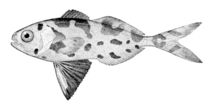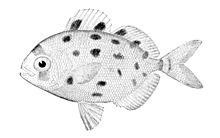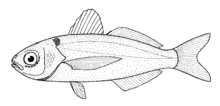- Nomeidae
-
Derivantes

Derivante aleta azul (Psenes pellucidus)Clasificación científica Reino: Animalia Filo: Chordata Clase: Actinopterygii Subclase: Neopterygii Infraclase: Teleostei Superorden: Acanthopterygii Orden: Perciformes Suborden: Stromateoidei Familia: Nomeidae Géneros ver en el texto
Los derivantes (familia Nomeidae) son una familia de peces marinos incluida en el orden Perciformes, distribuidos por mares tropicales y subtropicales.[1] Su nombre procede del griego nomeys, -eos, que significa pastor.[2]
El cuerpo puede alcanzar hasta 1 metro de longitud máxima.[1] Tienen dos aletas dorsales, la primera con 9 a 12 espinas delgadas, la segunda con 0 a 3 espinas y 15 a 32 radios blandos; mientras que la aleta anal presenta 1 a 3 espinas.[1]
Géneros y especies
Existen 18 especies agrupadas en 4 géneros:
- Género Cubiceps (Lowe, 1843)
- Cubiceps baxteri (McCulloch, 1923)
- Cubiceps caeruleus (Regan, 1914) - Derivante o Pez medusa.
- Cubiceps capensis (Smith, 1845)
- Cubiceps gracilis (Lowe, 1843) - Savorín
- Cubiceps kotlyari (Agafonova, 1988)
- Cubiceps macrolepis (Agafonova, 1988)
- Cubiceps nanus (Agafonova, 1988)
- Cubiceps paradoxus (Butler, 1979) - Derivante colón (en México), Pez medusa (en España) o Piña camote (en Ecuador).
- Cubiceps pauciradiatus (Günther, 1872) - Derivante ojón.
- Cubiceps squamiceps (Lloyd, 1909) - Savorín indio.
- Cubiceps whiteleggii (Waite, 1894) - Savorín indio.
- Género Nomeus (Cuvier, 1816)
- Nomeus gronovii (Gmelin, 1789) - Derivante fragata protuguesa (en México), Pastorcillo (en Cuba y España) o Pez azul (en Perú).
- Género Parapsenes (Smith, 1949)
- Parapsenes rotundus (Smith, 1949)
- Género Psenes (Valenciennes en Cuvier y Valenciennes, 1833)
- Psenes arafurensis (Günther, 1889)
- Psenes cyanophrys (Valenciennes, 1833) - Derivante rayado (en México) o Pastorcillo amarillento (en Cuba y España).
- Psenes maculatus (Lütken, 1880)
- Psenes pellucidus (Lütken, 1880) - Derivante aleta azul.
- Psenes sio (Haedrich, 1970) - Derivante dos espinas.
Referencias
- Nomeidae (TSN 172535). Sistema Integrado de Información Taxonómica.
- "Nomeidae". En FishBase (Ranier Froese y Daniel Pauly, eds.). Consultada en junio de 2008. N.p.: FishBase, 2008.
Enlaces externos
 Wikimedia Commons alberga contenido multimedia sobre Nomeidae. Commons
Wikimedia Commons alberga contenido multimedia sobre Nomeidae. Commons Wikiespecies tiene un artículo sobre Nomeidae. Wikispecies
Wikiespecies tiene un artículo sobre Nomeidae. Wikispecies
- Género Cubiceps (Lowe, 1843)
Wikimedia foundation. 2010.



